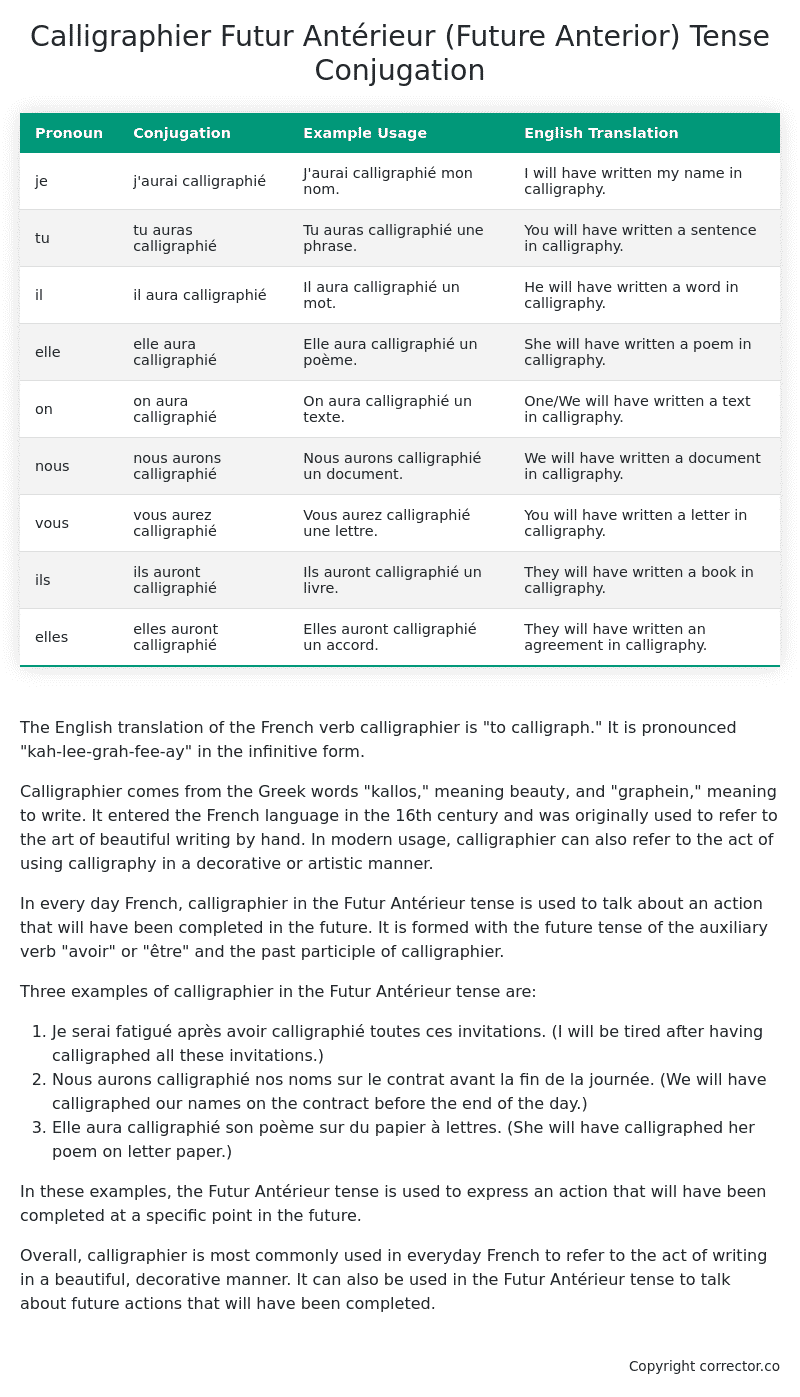Futur Antérieur (Future Anterior) Tense Conjugation of the French Verb calligraphier
Introduction to the verb calligraphier
The English translation of the French verb calligraphier is “to calligraph.” It is pronounced “kah-lee-grah-fee-ay” in the infinitive form.
Calligraphier comes from the Greek words “kallos,” meaning beauty, and “graphein,” meaning to write. It entered the French language in the 16th century and was originally used to refer to the art of beautiful writing by hand. In modern usage, calligraphier can also refer to the act of using calligraphy in a decorative or artistic manner.
In every day French, calligraphier in the Futur Antérieur tense is used to talk about an action that will have been completed in the future. It is formed with the future tense of the auxiliary verb “avoir” or “être” and the past participle of calligraphier.
Three examples of calligraphier in the Futur Antérieur tense are:
- Je serai fatigué après avoir calligraphié toutes ces invitations. (I will be tired after having calligraphed all these invitations.)
- Nous aurons calligraphié nos noms sur le contrat avant la fin de la journée. (We will have calligraphed our names on the contract before the end of the day.)
- Elle aura calligraphié son poème sur du papier à lettres. (She will have calligraphed her poem on letter paper.)
In these examples, the Futur Antérieur tense is used to express an action that will have been completed at a specific point in the future.
Overall, calligraphier is most commonly used in everyday French to refer to the act of writing in a beautiful, decorative manner. It can also be used in the Futur Antérieur tense to talk about future actions that will have been completed.
Table of the Futur Antérieur (Future Anterior) Tense Conjugation of calligraphier
| Pronoun | Conjugation | Example Usage | English Translation |
|---|---|---|---|
| je | j’aurai calligraphié | J’aurai calligraphié mon nom. | I will have written my name in calligraphy. |
| tu | tu auras calligraphié | Tu auras calligraphié une phrase. | You will have written a sentence in calligraphy. |
| il | il aura calligraphié | Il aura calligraphié un mot. | He will have written a word in calligraphy. |
| elle | elle aura calligraphié | Elle aura calligraphié un poème. | She will have written a poem in calligraphy. |
| on | on aura calligraphié | On aura calligraphié un texte. | One/We will have written a text in calligraphy. |
| nous | nous aurons calligraphié | Nous aurons calligraphié un document. | We will have written a document in calligraphy. |
| vous | vous aurez calligraphié | Vous aurez calligraphié une lettre. | You will have written a letter in calligraphy. |
| ils | ils auront calligraphié | Ils auront calligraphié un livre. | They will have written a book in calligraphy. |
| elles | elles auront calligraphié | Elles auront calligraphié un accord. | They will have written an agreement in calligraphy. |
Other Conjugations for Calligraphier.
Le Present (Present Tense) Conjugation of the French Verb calligraphier
Imparfait (Imperfect) Tense Conjugation of the French Verb calligraphier
Passé Simple (Simple Past) Tense Conjugation of the French Verb calligraphier
Passé Composé (Present Perfect) Tense Conjugation of the French Verb calligraphier
Futur Simple (Simple Future) Tense Conjugation of the French Verb calligraphier
Futur Proche (Near Future) Tense Conjugation of the French Verb calligraphier
Plus-que-parfait (Pluperfect) Tense Conjugation of the French Verb calligraphier
Passé Antérieur (Past Anterior) Tense Conjugation of the French Verb calligraphier
Futur Antérieur (Future Anterior) Tense Conjugation of the French Verb calligraphier (this article)
Subjonctif Présent (Subjunctive Present) Tense Conjugation of the French Verb calligraphier
Subjonctif Passé (Subjunctive Past) Tense Conjugation of the French Verb calligraphier
Subjonctif Imparfait (Subjunctive Imperfect) Tense Conjugation of the French Verb calligraphier
Conditionnel Présent (Conditional Present) Tense Conjugation of the French Verb calligraphier
Conditionnel Passé (Conditional Past) Tense Conjugation of the French Verb calligraphier
L’impératif Présent (Imperative Present) Tense Conjugation of the French Verb calligraphier
L’infinitif Présent (Infinitive Present) Tense Conjugation of the French Verb calligraphier
Struggling with French verbs or the language in general? Why not use our free French Grammar Checker – no registration required!
Get a FREE Download Study Sheet of this Conjugation 🔥
Simply right click the image below, click “save image” and get your free reference for the calligraphier Futur Antérieur tense conjugation!

Calligraphier – About the French Futur Antérieur (Future Anterior) Tense
Construction
Common Everyday Usage Patterns
Interactions with Other Tenses
For example
Summary
I hope you enjoyed this article on the verb calligraphier. Still in a learning mood? Check out another TOTALLY random French verb conjugation!


